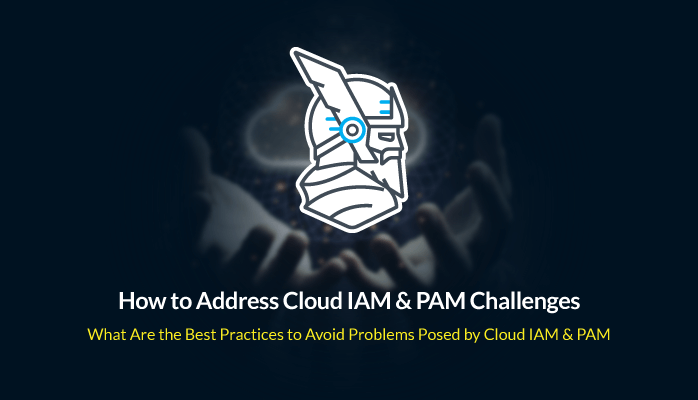Cloud computing has become a viable solution for companies large and small across all industries. Its accessibility, scalability, reliability, and flexibility are just a few of its benefits, which have led to its widespread adoption. However, although cloud environments primarily bring along a huge amount of advantages, they can also pose cybersecurity risks. Securing sensitive cloud IT settings from unauthorized entry remains one of the top issues for IT professionals, as they need to ensure that employees’ accounts are kept safe.
Yet, in a constantly evolving threatscape, maintaining user identities and access rights is becoming increasingly difficult.
How does an organization overcome Cloud IAM and Cloud PAM challenges?
Stick around until the end and find out how to tackle Identity & Access Management and Privileged Access Management in a cloud-based setup.
Understanding Cloud IAM and Cloud PAM Challenges
Grasping the concepts of Cloud Computing, Identity & Access Management (IAM), and Privileged Access Management (PAM) establishes the basis for action to address Cloud IAM and Cloud PAM challenges. In other words, as organizations rapidly transition to the Cloud, their security must always remain top-of-mind.
What is Cloud Computing
Cloud computing ensures that various resources such as applications, storage, servers, or networks can be easily accessed by its users. It offers a simpler means of leveraging resources by connecting users, networks, and any IT resource one can think of.
In general, the Cloud ecosystem is categorized as follows:
- Public Cloud – managed by a third-party provider and known for its multi-tenancy (its infrastructure supports multiple customers).
- Private Cloud – developed for and allocated to a single organization.
- Hybrid Cloud – a combination of on-premises services, Public, and Private Cloud.
Essentially, the Cloud is based upon a service-oriented architecture and is typically separated into three different models: Software-as-a-Service (SaaS), Platform-as-a-Service (PaaS), and Infrastructure-as-a-Service (IaaS).
Due mainly to its complexity, the cloud ecosystem requires a robust authentication and authorization process to protect its data and services.
In a cloud world, the lack of appropriate frameworks raises many concerns related to Identity & Access Management, data protection, security, and privacy. Due to the multi-tenancy characteristic specific to cloud environments, stronger authentication methods and access controls are vital.
Therefore, irrespective of the cloud’s promising and enticing functionality, companies may become hesitant to transfer their sensitive identification data to the cloud, and due to the aforementioned security challenges, its proliferation may sometimes become sluggish.
Defining IAM and PAM
First off, without conducting preliminary research, it might seem that (IAM) and (PAM) are equivalent. For the most part, both of them do involve managing users’ access and roles, however, their interchangeability would be a false representation.
Bear with me as I briefly outline what IAM and PAM are.
What is IAM?
Here is a broad definition of IAM provided by TechTarget:
Identity and access management (IAM) is a framework of business processes, policies and technologies that facilitates the management of electronic or digital identities. With an IAM framework in place, information technology (IT) managers can control user access to critical information within their organizations. Systems used for IAM include single sign-on systems, two-factor authentication, multifactor authentication and privileged access management. These technologies also provide the ability to securely store identity and profile data as well as data governance functions to ensure that only data that is necessary and relevant is shared.
Basically, IAM allows administrators to provide users access to very specific resources, at the same time enabling organizations to follow the Principle of Least Privilege, which specifies that no user should have more permissions than needed to successfully conduct his/her activity.
Through IAM, access control is managed by defining who has access to what IT resources. In this context, permissions to access a resource are not given directly to end-users but are rather grouped into roles that belong to a specific group of employees. With an IAM policy, one can establish what roles are granted to which members, and each policy will be connected to a specific resource. Should a user want to access a particular resource, the IAM system will verify if the policy allows the user to perform the intended action.
Cloud IAM, on the other side, differs from the standard IAM model in that it has been designed to integrate across all devices and systems, regardless of their location. And since the cloud migration can open entry points for attackers, cloud identity management allows for user access management and authentication on a broader scale. This aspect is crucial as it prevents ill-intentioned outsiders from reaching your sensitive data and systems.
Identity and Access Management ensures enhanced security in a cloud ecosystem, facilitating numerous operations such as authentication, authorization, or verification. In a nutshell, an IAM framework boosts the protection of cloud users by guaranteeing that the correct users are authorized on the cloud systems they are trying to access.
What is PAM?
Once again, I would like to highlight the fact that PAM and IAM are not the same.
According to TechTarget:
Privileged access management (PAM) is the combination of tools and technology used to secure, control and monitor access to an organization’s critical information and resources. Subcategories of PAM include shared access password management, privileged session management, vendor privileged access management and application access management.
(…)
PAM software and tools work by gathering the credentials of privileged accounts, also known as system administrator accounts, into a secure repository to isolate their use and log their activity. The separation is intended to lower the risk of admin credentials being stolen or misused. Some PAM platforms do not allow privileged users to choose their own passwords. Instead, the password manager of the platform will tell admins what the password is for a given day or issue one-time passwords each time an admin logs in.
Essentially, PAM is compounded of protection mechanisms addressed towards users with privileged access.
As a quick recap, while PAM safeguards employees with elevated rights, IAM tackles the regular/everyday users of an organization. Because of this audience disparity, PAM and IAM differ in scope: IAM protects against a limited number of industry-specific threats, whereas PAM safeguards access to critical business functions.
What about Cloud PAM?
Cloud PAM is also designed for complex cloud settings to ensure privileged session control. It provides a seamless operational process experience when it comes to all privileged user activities.
Keep in mind that although IAM systems are perfect for setting up and removing the access, they don’t offer that much visibility and reporting capabilities as far as privileged access is concerned. The issue here is that the current regulations require organizations to permanently monitor and log the actions of privileged users (i.e. system administrators), and a PAM solution does just that: it provides tracking of what a privileged user does in a given environment and offers great visibility and granular control over elevated sessions.
In essence, given the security risks posed by privileged users, a PAM solution should be implemented in the first place, succeeded by a complimentary IAM solution.
HeimdalTM Security’s PAM solution is cloud-delivered and prepared to equip today’s both office-bound and remote workplaces’ needs. It removes the hassle of granting admin rights by automatically providing users with elevated privileges for a limited time only and eradicates the pain of manual approvals and installs. Our truly next-gen Privileged Access Management tool is a crucial tool for scalability, managing user rights, software installs, keeping logs and audit trails, achieving data protection compliance, and more.
System admins waste 30% of their time manually managing user rights or installations.
Thor AdminPrivilege™
is the automatic Privileged Access Management (PAM) solution
which frees up huge chunks of sys-admin time.
- Automate the elevation of admin rights on request;
- Approve or reject escalations with one click;
- Provide a full audit trail into user behavior;
- Automatically de-escalate on infection;
How to handle Cloud PAM and IAM issues
Besides the traditional IAM & PAM issues that are affecting today’s organizations, such as user password fatigue and managing a distributed workforce, here are some examples of cloud-related challenges that companies may face:
- Inability to properly detect, prevent, and monitor.
- Excessive privileges (too many accounts with admin rights).
- Inactive users or former employees (which increases the risk of privilege creep).
- Lack of governance and compliance.
- Users (intentionally or unintentionally) bypassing enterprise IAM controls.
Why is IAM important for cloud computing?
As identity has become the most important component when controlling access (also see the biometric-driven authentication topic), it will determine what cloud data they can access.
However, in a cloud-based scenario, sensitive data will be stored in a remote server. And since employees require access to a system, they will do so by logging in via their browser or through an app. Should a malicious hacker intend to access the company’s files, what he/she would have to do is steal the target’s login credentials.
What IAM does is it impedes identity-based attacks and data breaches that come from credentials abuse, thus they become vital in cloud computing and especially for managing a remote workforce.
The same goes for PAM.
Although cloud providers typically offer a stable and safe infrastructure, security concerns for other components such as data and applications can fall on your shoulders. With PAM, thanks to its role-based access management, your company can help securely handle privileged users.
PAM will make sure those highly important privileged accounts and passwords are centrally handled, facilitating advanced functionalities for management and monitoring.
The cloud provides organizations with more scalable and cost-effective solutions. Yet, challenges with this model do exist. So, a proper understanding of cloud-based risks is required for all aspects ranging from the accounts and passwords used to protect the organization, to the tools and roles the company employs. Therefore, as cloud usage continues to grow, in order to properly handle risk, enterprises must get on top of both privileged and non-privileged account access.
Here are a few tips on how to better handle IAM & PAM challenges:
- Gain the ability to automatically de-provision user access to cloud-based resources – to rest assured that when someone is no longer with the company, the company’s data remains safe.
- Have complete visibility – keep clear audit trails of who is doing what.
- Use cloud-based solutions – so that all user identities and privileges are easily managed regardless of the user’s location.
- Maintain good password hygiene and avoid common password mistakes.
- Study PAM Security Essentials and learn how to plan your Access Governance strategy.
Conclusion
Organizations expect to be able to rely on uninterrupted IT resources at all times, no matter where their data and employees reside. Securing Cloud access with PAM and IAM reduces costs and allows companies to focus on other strategic security priorities.


What are your primary Cloud IAM and Cloud PAM challenges? Let us know in the comments section below!













